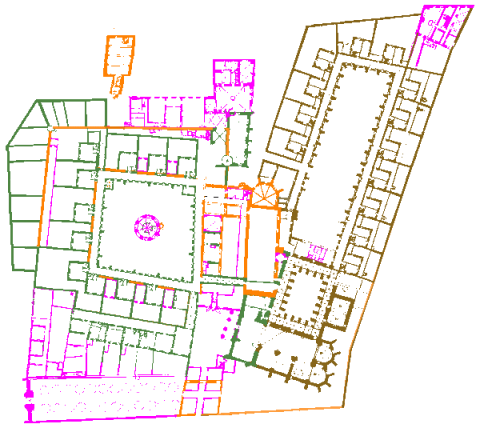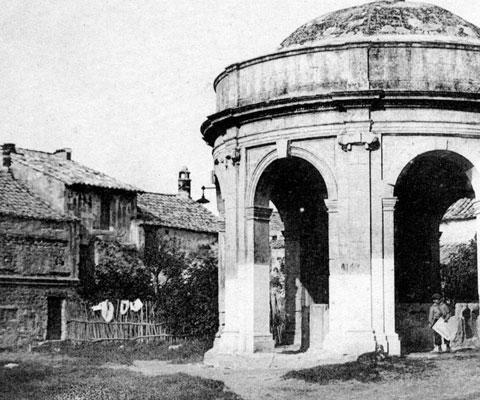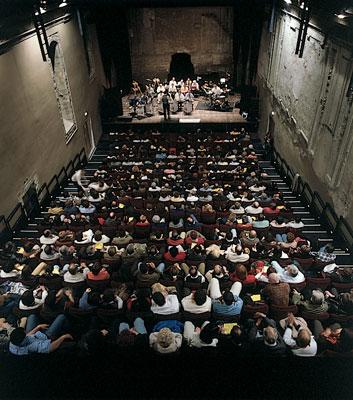1649-1973 : THE HEIGHT OF THE MONASTIC ERA. RICHES AND REVOLUTION, LAITY
(from the Minster of Faith to the Minister of Culture)
La Chartreuse was at its peak, it was the richest monastery in France. Nearly 100 persons lived here, including 24 fathers and 30 lay brothers, and as many domestics and workers. The wealth of the community was clearly seen in the gilt and the marble, in the sculptures and the paintings which hung on the walls.
In 1649, the project for a monumental entranceway that had been under discussion for four years was finally completed by the architect François Royers de la Valfenière. The Baroque exuberance is certainly not very Carthusian, yet this entrance does reflect the taste of the time and the spirit of the Counter-Reform. In 1660, King Louis XIV entered the gate with great ceremonial ritual, followed by his large retinue. At the dawning of the 17th century, nearly everything was completed except for the Chapel of the Dead, which was later built in the cemetery cloister. Only finishing work still remained on the rest of the monastery, which was now more an economic centre than a religious centre. Barns were built, as were accommodations, a wood storehouse, a hospital and the domestics’ kitchen. Saint John’s fountain was covered with a roof. Outside La Chartreuse, revolutionary fervour was rising to a pitch. Three dates suffice to tell of the collapse of a world that had lasted over four centuries:
- 14 February 1790: religious orders were abolished and forbidden.
- late 1792: the Carthusian fathers had to leave
- 27 May 1793: the monastery was put up for sale.
The lands and the buildings which belonged to La Chartreuse were declared to be national property and were divided into 17 different lots and auctioned off in Beaucaire on 1 Thermidor in Year II (which was 19 July 1794 on the pre-revolutionary calendar). The "paintings, marbles, woodwork and frescoes in the church and the adjoining chapels, the sacristy and the refectory" were not for sale. The sale also included the 8500 books in the library, the medal collection and other riches which were all scattered and most of which vanished. Thanks to the inventory established in 1791 we have a very slight idea of the artistic and artisan treasures that had existed in La Chartreuse. In the 19th century, La Chartreuse continued to deteriorate and the neighbourhood suffered accordingly and acquired a bad reputation. When Prosper Mérimée visited in 1834, La Chartreuse was no longer a visible entity and the only interest shown as for the sculpted tomb of Pope Innocent VI and the damage it had sustained. Barrels, olive tree trunks, ladders and other farm implements had all been stored willy-nilly in the former funeral chapel. The farmer had gouged into the walls to create a closet.” The report Prosper Mérimée wrote was also an indictment, an alarm sounded in the ear of the government for it to assume its responsibilities and the expense of preserving French heritage. It took another seventy-five years before the alarm bell was heard.
In the 20th century, La Chartreuse was renovated. In 1909, architect Jules Formigé, submitted his “Report on La Chartreuse de Villeneuve-lès-Avignon" to the Historical Monument Commission which established a very precise inventory and called for action. The French government undertook action which lasted nearly seventy-five years, summed up in three words: acquire, restore, rehabilitate.
Bit by bit, the French government purchased the lands and buildings from over three hundred different private owners who occupied the premises. Restoration got underway and continues today. This prestigious building then acquired a soul, in 1973, with the creation of the CIRCA and its ambitious cultural project of making La Chartreuse a French Villa Medicis. This is the beginning of a new chapter in the history of La Chartreuse, which you can explore by visiting the web pages for the C.N.E.S. (National Centre for Writing for Theatre and Performances) on the La Chartreuse website.





